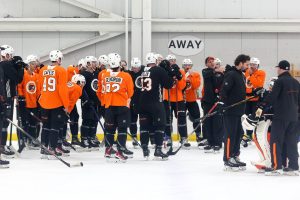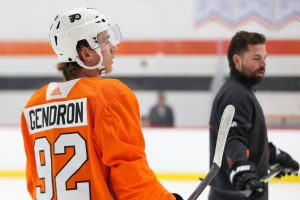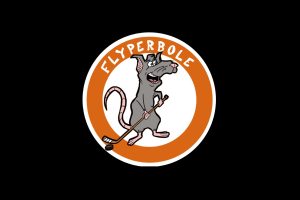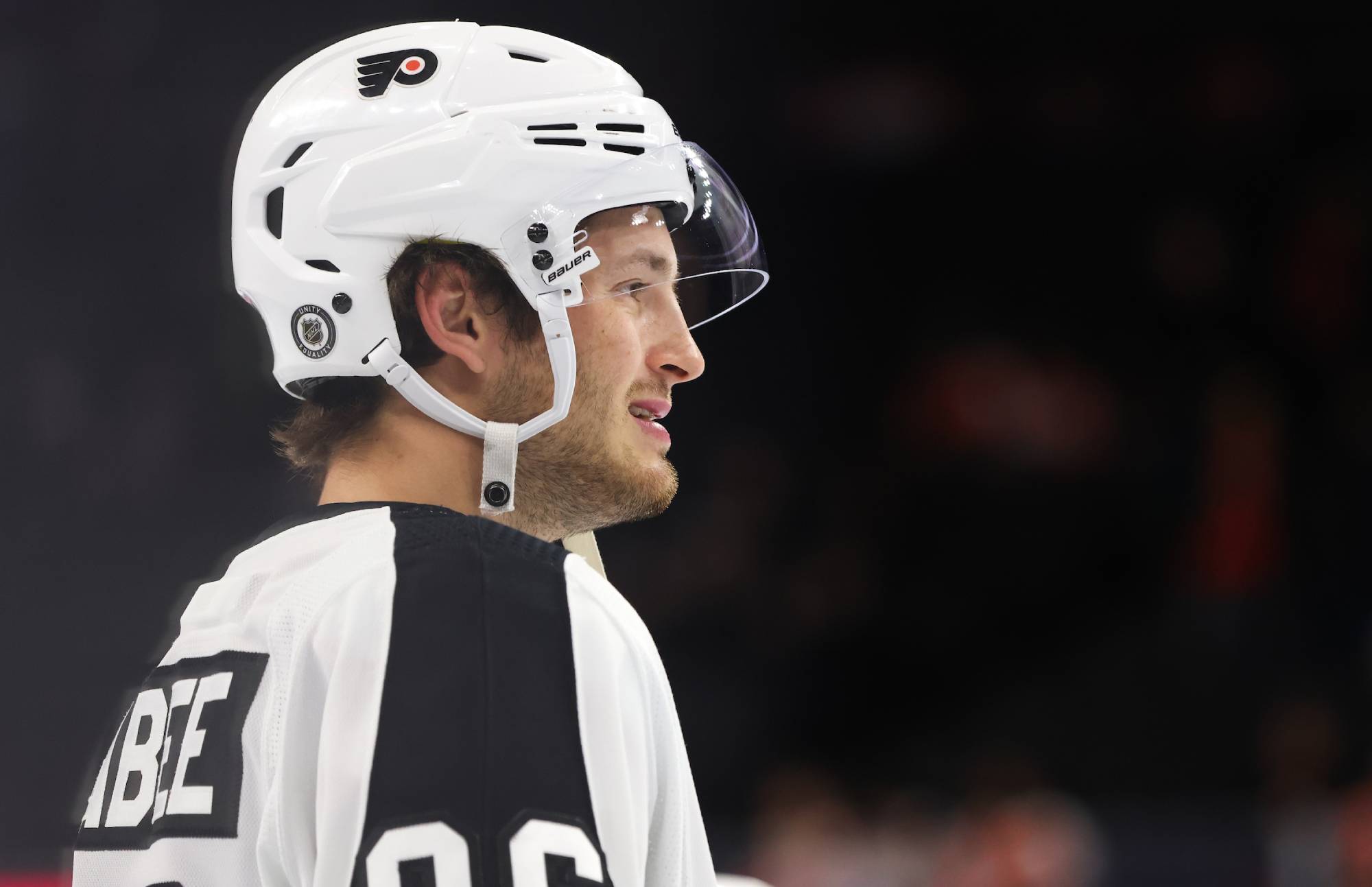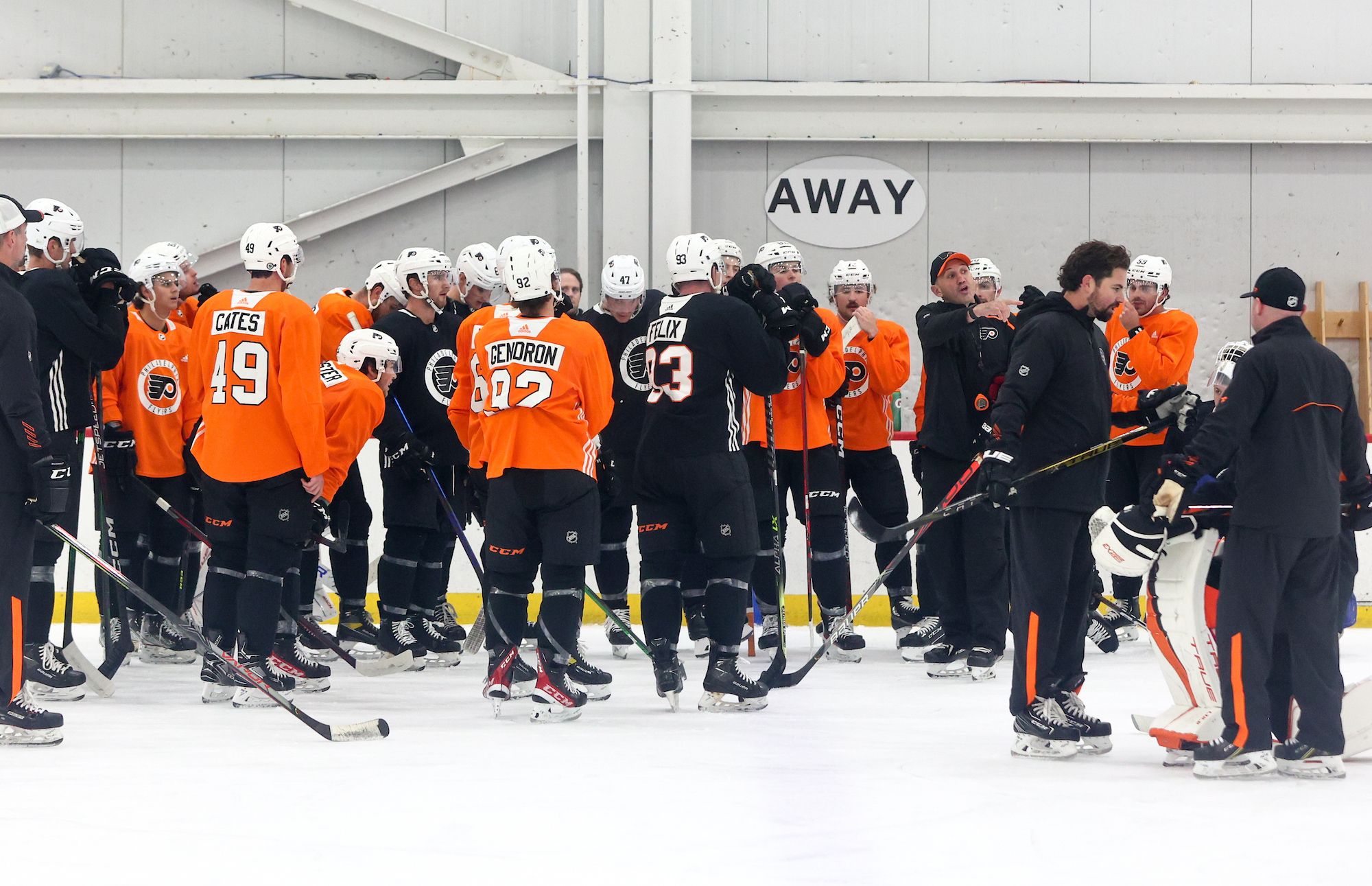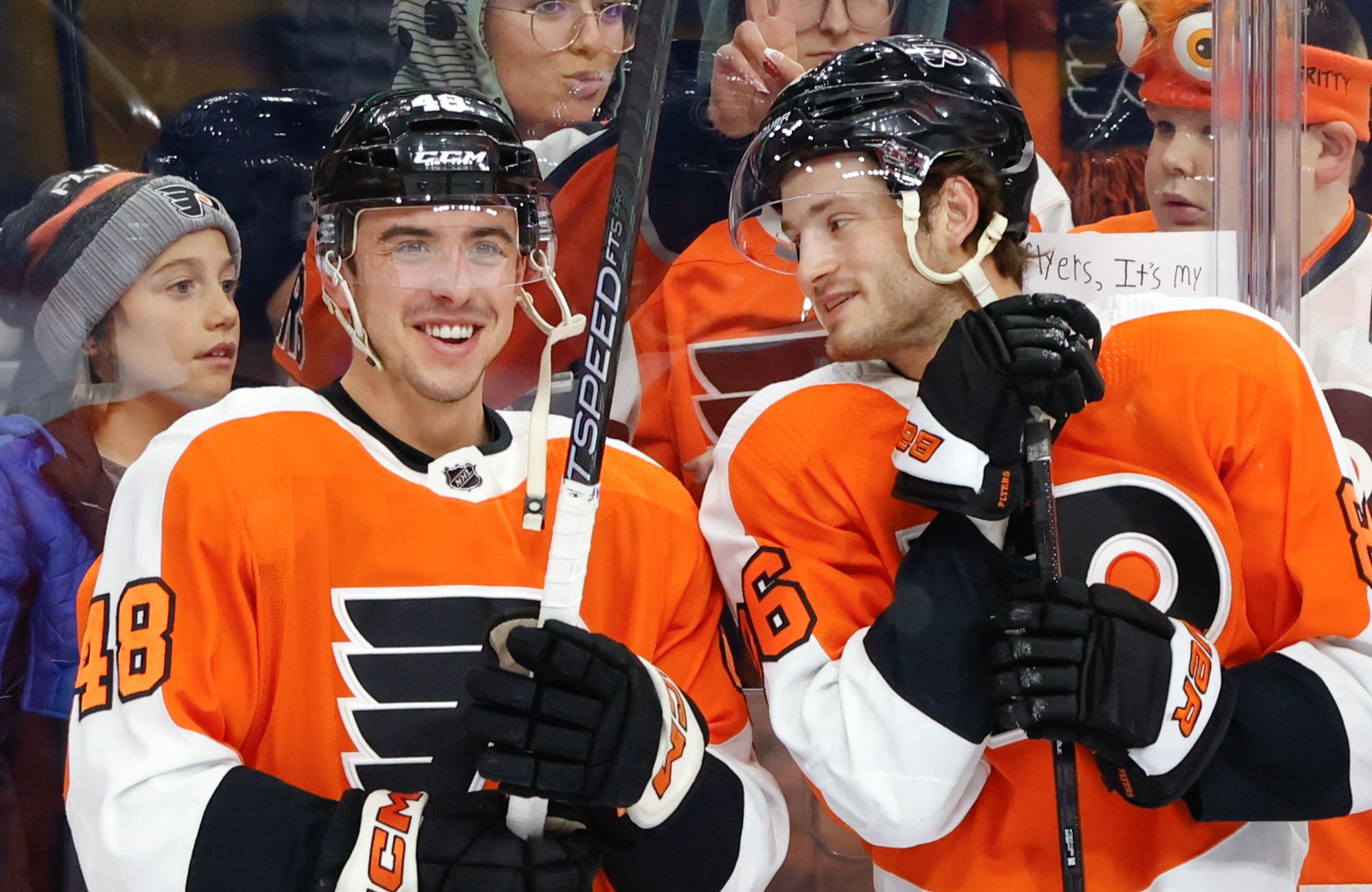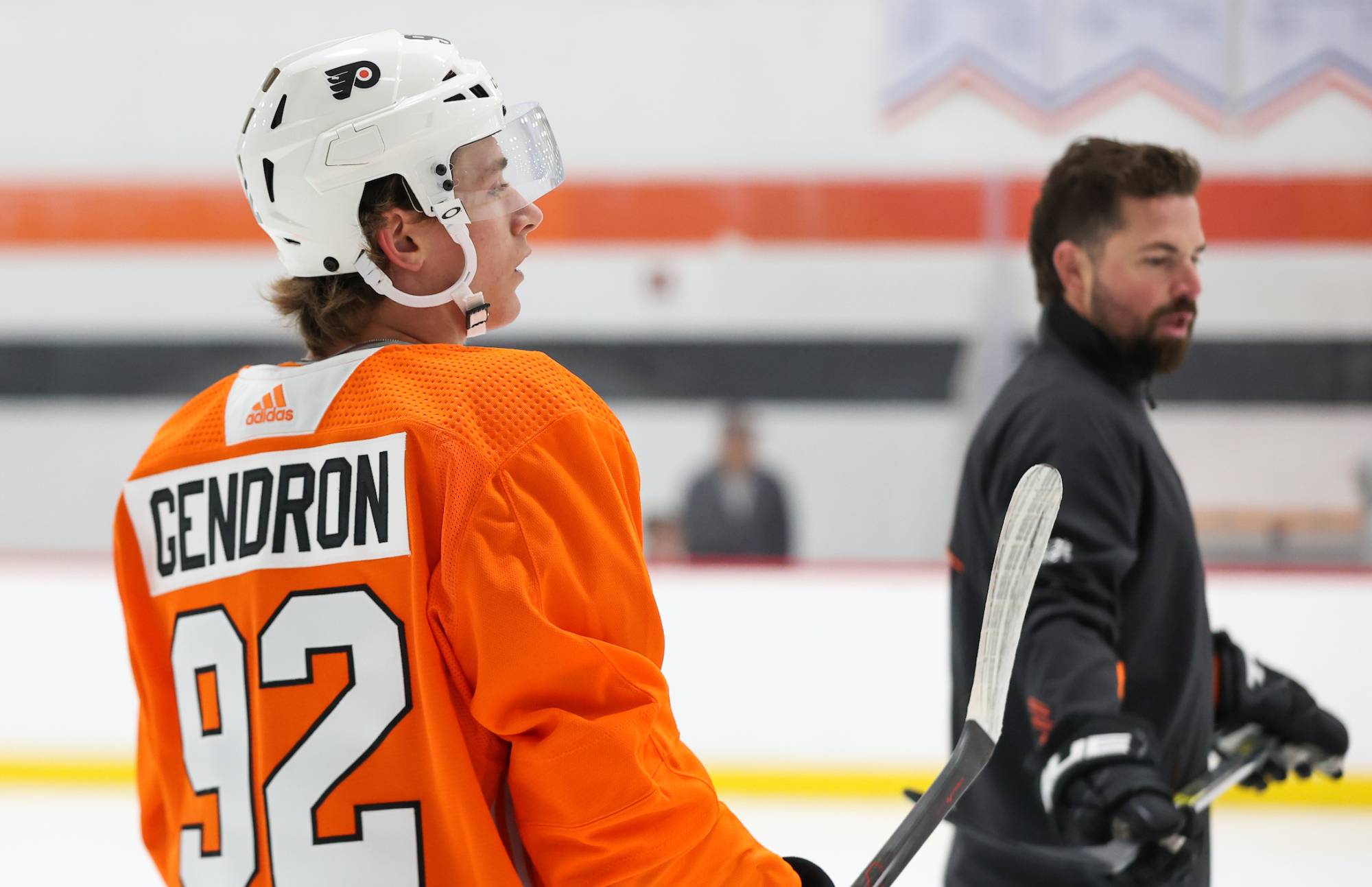Morning Observations is a feature where we break down the previous night’s game with an analytical eye.
#1: Defensive issues didn’t disappear despite Ghost scratch
Even though the Flyers won on Thursday night against the Vancouver Canucks, some lineup changes were inevitable, for a few reasons. To start, Mark Streit was finally ready to return from injury, which would require one defenseman to sit in his place. In addition, Radko Gudas had missed Thursday due to a “healthy” scratch and watched the defense be especially mistake-prone in his absence, so he was almost certainly coming back in. There were a number of candidates for scratching (in addition to Nick Schultz, who is clearly #8 on the depth chart and was definitely sitting), as one could make a case for basically every single player on the defense following Thursday’s sloppy affair. However, the news that Shayne Gostisbehere would be the choice still came as a bit of a shock, even if Ghost certainly struggled in his own zone versus Vancouver.
Gostisbehere wasn’t the only one who performed poorly, though. Michael Del Zotto took two penalties that created 5-on-3s. Brandon Manning also was penalty-prone. Ivan Provorov delivered his worst game in months. And of course, there’s Andrew MacDonald, whose overall play-driving metrics at 5v5 remain the worst on the team. Instead, Gostisbehere was the one who took a seat, likely due to recent inconsistent defensive play accompanied by no tangible point production to offset it.
The problem with that justification, however, is that Gostisbehere isn’t alone in struggling defensively. The whole team is flailing in that area, and that continued yesterday. It was most apparent on the Krug and Chara goals; the former an example of blown rush coverage by Streit and Weise, and the latter terrible cycle coverage allowing a clean pass through the slot. Turnovers were also an issue, specifically early, as both Brandon Manning and Brayden Schenn coughed the puck up on separate plays in the first period only to be bailed out by the post. The Flyers allowed 22 regular scoring chances at 5v5 and 10 of them were high-danger, which are surely far more than Dave Hakstol wants to see his team permit. Considering the recent team-wide defensive struggles, I see how it’s tempting to think to bench a player who has a reputation for poor coverage. But benching Ghost yesterday did nothing to solve Philadelphia’s recent woes without the puck, and it made the team far less dangerous with it.
#2: Is it time to panic?
Following their ten-game winning streak, the Flyers have posted a 3-7-3 record, and have nearly given back all of their gains from that mid-December run. Yes, Philadelphia still technically holds the final wild card position in the East, but that’s only because they have games in hand over their closest competition. By Points Percentage (how many standings points earned out of all possible points), the Flyers are behind both the Toronto Maple Leafs and Carolina Hurricanes. Regardless of whether they can take down the Capitals today, there’s a very good chance that Philadelphia will be officially out of a playoff spot by the end of their bye week.
There are some positive signs, however. The Flyers’ power play remains fantastic (scored twice yesterday), the penalty kill has legitimately improved to the point where it’s at least in the top-half of the NHL, and the return of players like Couturier and Read has Philadelphia with a 51.16% score-adjusted 5v5 Corsi over their last ten games. They’ve even been a positive xG team over that stretch (50.63%), a stat where they’ve performed poorly all year. Three problems remain. First, the goaltending has not done the team any favors. Second, the team defense — defensemen and forwards — has been prone to egregious coverage breakdowns. Third, the lineup is still not fully optimized. The good news on the third point is that it’s getting closer, as the only major issue left is the continued presence of Andrew MacDonald as a top-four defenseman and partner for Ivan Provorov. I do believe that solving #3 will go a long way towards addressing #2, but #1 will remain a problem until one of Steve Mason or Michal Neuvirth regains his 2015-16 form. That, to me, is the biggest concern moving forward for the Flyers.
NHL.com Report & Highlights | Corsica.Hockey Game Recap Page | HockeyStats.ca Recap | NaturalStatTrick Recap | HockeyViz.com | BSH Recap | Meltzer’s Musings
#3: How to evaluate Hakstol?
Dave Hakstol’s rookie season as a head coach at the NHL level was nothing short of a smashing success. Working with a well below-average defense corps, he overhauled the Flyers’ tactics and turned them into a more aggressive, more effective club that used a late-season surge to make the playoffs. Young players like Shayne Gostisbehere, Sean Couturier and Brayden Schenn flourished in the Hakstol system, and it was that developmental success that seemed to bode so well for the team’s future.
Year two has been a different story entirely. Cracks are starting to show in the tactics — too many perimeter shots in the offensive zone, too many coverage breakdowns defensively — but most concerning has been the lineup decisions. The issues have ranged from annoying but ultimately of little consequence (3v3 overtime player usage, shootout decisions) to truly damaging (MacDonald placed in roles well above his talent level despite awful play-driving metrics). Yesterday, it was the decision to scratch Shayne Gostisbehere that had fans in an uproar. Ghost, of course, was already scratched once this season in a “message sending” move, but a coach can only go to that well so often. This felt like Hakstol believing that the team was more likely to beat Boston with MacDonald, Brandon Manning and Michael Del Zotto in the lineup over Gostisbehere. Unsurprisingly, the vast majority of fans on social media disagreed.
For the record, the stats do not support Hakstol’s decision to bench Ghost, if it truly was due to a belief that he has been the defense’s worst player recently. Gostisbehere leads the defense in score-adjusted Corsi, Corsi relative to his teammates, and Expected Goals For percentage. His usage (lots of offensive zone starts and shifts against bottom-six forwards) likely inflates those metrics a bit, but in any case, the Flyers largely have controlled play with Gostisbehere on the ice at 5v5 this season. For some, this was a “last straw” decision, and many fans seem to be losing faith in their team’s coach.
Don’t for a second believe that the Flyers’ organization is anywhere near that point. Not only did Ron Hextall sign Hakstol to a lucrative five-year contract, the coach’s overall track record is perfectly adequate. Yes, the team is struggling right now, but they remain in a playoff spot (however tenuous their hold on it is) and the season is far from over. By my estimation, the Flyers are at best the fourth or fifth most talented team in the East, so it’s not like the team is dramatically underachieving on the whole, and they probably overachieved last season. However, that doesn’t mean he should be immune to criticism. Most of the “bad” lineup and usage decisions have a small impact on win probability in isolation, but in aggregate, they’ve probably cost the Flyers a couple wins so far. That’s a legitimate problem. I’ll put it this way — Ron Hextall rightfully expects this team to make the playoffs this year, and if they miss out, he’ll surely take a long, hard look at whether Hakstol is the right guy for this team. But he’s not going to do anything rash, no matter the outcry from fans.
#4: Odd first period for Flyers
The Boston Bruins are actually the best team in the NHL when it comes to driving play at 5v5, so that’s why the Flyers’ start to yesterday’s game was so surprising. They got the jump on the Bruins, blasting 20 shot attempts in the direction of Tuukka Rask and allowing just eight during 5-on-5. But somehow, despite finishing the period with a 71.43% Corsi, Philadelphia was actually lucky to hit the first intermission with the game tied at one goal apiece. Boston hit two posts, both a direct result of a brainless defensive zone turnover (one from Manning and one from Schenn). Twice, the shooter cleanly beat Neuvirth only to be stymied by the iron. That’s why the deluge of chances (15 for Boston) in the middle stanza was no shock. Philadelphia’s defensive zone play was a mess from the jump, and once the forecheck began to lose its effectiveness, Boston easily took this game over.
#5: Best game in weeks for the Bellemare line
A big reason for Philadelphia’s territorial dominance in the first period was the play of the team’s fourth line, consisting of Pierre-Edouard Bellemare, Chris VandeVelde and Roman Lyubimov. Recently relegated to a minimal role at 5v5, Dave Hakstol had no choice but to increase the minutes of the line a little bit, simply because no trio was more effective in the early going. They put the Flyers on the board early, as Bellemare deflected an Ivan Provorov point shot past Rask for his second goal in as many games. They kept up the pressure, and actually finished as the only three Flyers above a 59% score-adjusted Corsi.
It wasn’t a perfect game for the line, however, as it was their poor defensive zone coverage that allowed for Zdeno Chara’s second period goal. But aside from that one bad shift, they played about as well as was realistically possible. Even in their strongest game in a long time, Hakstol could only find seven minutes of 5v5 ice time for them. Part of that is because Philadelphia spent lots of time on the PK and two members of the line get heavy minutes in that situation, but it’s also driven by their place on the depth chart. This is truly the Flyers’ fourth line for the foreseeable future.
#6: Schenn’s line starting to struggle
When the line of Brayden Schenn, Wayne Simmonds and Dale Weise was put together last week, it appeared to be one of those “so crazy it just might work” type of ideas. Each player seemed like an ill fit for the role at first glance — Schenn at center, Simmonds on line three, Weise on a “scoring” line. But in their first three games together, the unit drove play, especially dominating on the cycle in the offensive zone. Unfortunately, their suprisingly-strong performance appears to be tailing off.
For the second straight game, the Schenn line was heavily outshot and also outscored. Against the Canucks, Schenn posted a 22.73% Corsi For percentage, and yesterday it was at 27.78%. All that volume is also turning into tangible goals against, as they’ve been on the ice for four opponents’ tallies in the past three games. A performance like this usually results in a lineup shakeup, so my guess is that the line might be broken up as soon as today. If so, it’s not an unjustified decision.
#7: Couturier struggled mightily
Sean Couturier was rightfully praised by his coach after Thursday’s game for “leading the way” and generally looking like the best player on the ice against the Canucks. That’s why it was so disappointing to see the Flyers’ second line center deliver such a poor performance just two days later. His 42.79% score-adjusted Corsi was the worst by a forward not on the Schenn line, and just as Couturier was the primary driver of his unit’s success on Thursday, he was the main reason his line struggled yesterday.
His linemates put Couturier in positions to score on multiple occasions, but he simply could not take advantage. Either Couturier would hesitate with the puck in a dangerous position just long enough to allow for Rask to get set, or he would just miss the net entirely, as he did on a breakaway opportunity. Couturier is justly defended by those open to advanced statistics, because he does drive play and scores at a better rate at 5v5 than most realize. But he’s simply not an impact offensive player on a nightly basis at this point in his career, and yesterday was another reminder of that fact.
#8: Streit looked like a guy who missed a month
The Flyers were right to want Mark Streit back in the lineup once healthy. He certainly has his detractors, but the 39-year old is still a useful NHL defenseman who is not a liability from a play-driving standpoint and can chip in offensively. In fact, considering Del Zotto’s poor defensive play this season, there’s a strong case to be made that even an aging Streit is the fourth-best defenseman on the roster, after Provorov, Gudas and Gostisbehere. However, some rust was inevitable, and Streit definitely delivered an uneven performance.
His raw on-ice shot attempt differential doesn’t show signs of weakness, as Streit posted a solid 50.82% score-adjusted Corsi. But his mistake-prone game does show up in the scoring chance totals. With Streit on the ice, the Flyers allowed seven chances to the Bruins, while creating only two of their own. Turnovers were the biggest issue, though Streit wasn’t exactly sharp in coverage, either. The Flyers are still better off with the veteran back in the lineup instead of MacDonald or Del Zotto (this year’s version), but it wasn’t exactly an amazing return to the lineup.
#9: Secondary PK units most effective
So far this season, Hakstol has selected the forward duo of Pierre-Edouard Bellemare and Chris VandeVelde to be his top penalty kill unit. Ivan Provorov, Andrew MacDonald and Radko Gudas have received similar responsibilities on the back end. However, it’s been the players further down the rotation that have been the most effective in terms of shot suppression. Sean Couturier (unsurprising), Wayne Simmonds (more surprising) and Brandon Manning (especially surprising) grade out very well in this area.
Some of the discrepancy between the stats and the roles can be explained due to usage — the top PK guys get more defensive zone faceoffs, and also face top units more often — but the secondary guys have been far more efficient in preventing power plays from getting set up in formation and firing away. That was the case again yesterday, as Couturier, Lyubimov, Del Zotto, Simmonds and Manning all finished with Corsi Against per 60 rates below 90, while the top duos were above 130. I’ve long advocated for Couturier to be used as the top penalty killer in terms of ice time, and the stats continue to back that up.
#10: Provorov-MacDonald back to top pair duties
Around the turn of the calendar year, Hakstol slowly began shifting top pair responsibilities away from the Ivan Provorov/Andrew MacDonald duo and towards the 2015-16 season’s preferred combination of Michael Del Zotto and Radko Gudas. However, the past two games have shook up everything, with Gudas being scratched on Thursday and then being paired with Streit in his return to the lineup today. As a result, Hakstol seems to be falling back on his trust in the 9-47 pair. Both received over 16 minutes of 5v5 ice time, and no duo faced the Bergeron line more. To the pair’s credit, they held their own at even strength, finishing slightly above 50% in Corsi and slightly below in xG. Still, the past month has shown that this duo cannot drive play in a top pair role, so I hope that this isn’t a sign of things to come.

